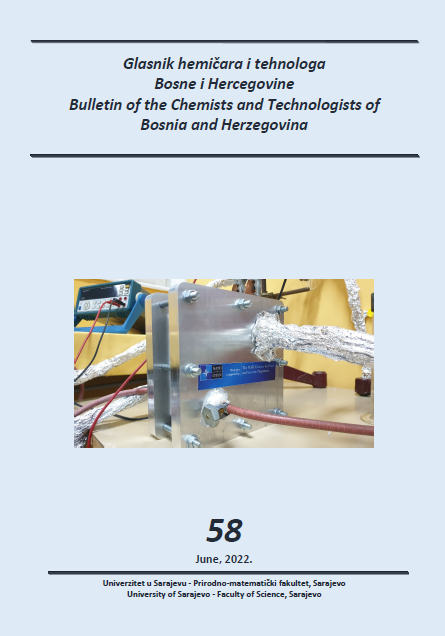|
|
Bulletin of the Chemists and Technologists of Bosnia and Herzegovina
Issue 58
Publication date: June 2022 |
|
Table of contents
Phenolic content and bioactivity of two sour cherry cultivars and their products Original Scientific Article
Kazazic, M., Mehic, E., Djapo-Lavic, M.
DOI: 10.35666/2232-7266.2022.58.01
UDK: 547.56:634.233.002.2
Abstract: Bioactive compounds are produced as secondary metabolites in plants. Positive correlation between presence of bioactive compounds and health benefits of plants have been reported in many studies. Sour cherry contains high content of bioactive compounds, mostly polyphenols and anthocyanins. They are mostly consumed in fresh state, but are also used to produce jam, jelly, marmalade, juice, and syrup. Aim of this study was to evaluate total phenolic content, anthocyanins, as well as the antioxidant activity in two sour cherry cultivars and their products, jams and juice, prepared using traditional recipes. Total phenolic content was determined using Folin-Ciocalteu method and antioxidant activity was assessed using ABTS radical cation decolorization assay. pH-Differential method was used to determine anthocyanin content. Marasca cultivar had higher content of phenols, anthocyanins and antioxidant activity than Oblačinska cultivar. Processing of sour cherries had a greater impact on the reduction of anthocyanin content but did not have significant effect on antioxidant activity.
Bulletin of the Chemists and Technologists of Bosnia and Herzegovina 58, 1-6.
Extractability of sodium ions from soil Original Scientific Article
Sulejmanović J., Jurković J., Ajanović T., Selović A., Nuhanović M., Ajanović A., Kovo K., Durić L., Botonjić M.
Abstract: In this study, soil samples from two selected locations: “A” (alluvial soil) and “B” (clay loam) were analyzed. Chemical analysis of soil samples included determination of soil pH and soil suspension conductivity. Two different extraction methods were applied: shaking and ultrasound method for extraction of sodium ions from soil with three solvents (aqua regia, 5% CH3COOH and distilled water). The values of pseudo-total (extracted with aqua regia) and bioavailable Na content (extracted with 5% CH3COOH and distilled water) in the soil sample “A” were in the range of 46.35-66.55 mg Na/kg; 14.77-18.59 mg Na/kg and 12.58-15.20 mg Na/kg of soil, respectively, by applying shaking method. By the same method, in the case of soil sample “B” the ranges were 17.15-75.66 mg Na/kg; 20.87-32.80 mg Na/kg and 4.62-20.33 mg Na/kg of soil, for the extraction by aqua regia, 5% CH3COOH and distilled water, respectively. Ultrasonic extraction in all cases gained higher results compared to the shaking method. In general, the application of ultrasound shows a positive effect on the extractability of Na+ ions from soil samples.
Bulletin of the Chemists and Technologists of Bosnia and Herzegovina 58, 7-18.
Synthesis, IR characterization and antioxidant capacityof Cu(II) complexes with amino acids and melatonin Original Scientific Article
Ljubijankić, S., Galijaševic, S., Davidović-Plavšić, B., Balaban, M., Ljubijankić, N.
DOI: 10.35666/2232-7266.2022.58.06
UDK: 613.84 [546.48:546.17]
Abstract: Studies have shown that cigarette smoking affects the accumulation of some heavy metals in certain tissues and metabolism of essential elements. The aim of the study was to determine the differences in the concentrations of cadmium in the blood and urine and zinc in the urine of smokers and ex-smokers in relation to non-smokers, and to determine the possible influence of cadmium concentration on zinc excretion as an essential element. The study included 106 subjects. Subjects were regular smokers (n=51), ex-smokers (n=38) and non-smokers (n=17). Atomic absorption spectrophotometry (AAS) with an electrothermal atomizer was used to determine cadmium. Zinc was determined by AAS with a flame atomizer. There was a significant difference in the values of cadmium in the blood between the groups: smokers and non-smokers (p<0.001), smokers and ex-smokers (p <0.001), and between ex-smokers and non-smokers (p = 0.045). There is a significant positive and strong correlation in the level of zinc and cadmium in urine per gram of creatinine, and as the level of cadmium increases, the level of zinc also increases (rho=0.781; p=0.001). The data indicate that cigarette smoking has been shown to be a factor that can increase cadmium levels to an extent that will significantly increase zinc excretion, or its increased loss.
Bulletin of the Chemists and Technologists of Bosnia and Herzegovina 58, 19-32.
Temporal evolution of electrical resistance through the granular packing of Ni beads Original Scientific Article
Dujak, D., Đekić, M., Ćubela, D.
DOI: 10.35666/2232-7266.2022.58.04
UDK: 538.9:537.311.6”71”
Abstract: In this paper we investigate the temporal evolution of the electrical resistance through different two-dimensional (2D) packings of Ni beads when 1 mA current is injected in them. In the first stages of measurements, resistance decreases towards a saturation value and it can be fitted with Mittag-Leffler function. Fitting parameters show that the relaxation dynamics does not depend on the type of the packing. Different packings show differences in the initial values of the resistance which is attributed to the formation of new microcontacts during the formation of the new packing. Pauses in the flow of the current cause the resistance either to decrease, increase or remain the same, depending on the packing. Longer measurements show, that after the initial drop, the resistance starts to rise which can probably be attributed to the deterioration of microcontacts between the beads. Small variations in temperature do not affect the temporal evolution of the resistance.
Bulletin of the Chemists and Technologists of Bosnia and Herzegovina 58, 33-38.
Investigation of the effect of the addition H2O2 on the general corrosion of brass in hydrochloric acid Short Communication
Kasapović, D., Bikić, F.
DOI: 10.35666/2232-7266.2022.58.05
UDK: 620.196[546.131:669.35'5]
Abstract: In this paper, the influence of hydrochloric acid and the addition of oxidizing agents on the rate of general corrosion of brass was investigated. For comparison, the corrosion rate of copper and zinc in hydrochloric acid and in hydrochloric acid with oxidizing agent was also tested. The Taffel extrapolation method was used to examine the general corrosion of brass, copper and zinc. The Taffel extrapolation method involves scanning potential of the working electrode of ±250 mV in relation to its open-circuit otential (EOCP), at a speed of 0.5 mVs-1. Investigation of corrosion was conducted in a corrosion cell according to the ASTM G5 (ASTM G5-94) standard, on a potentiostat/galvanostat instrument, Princeton Applied Research, model 263A-2, with PowerCORR® software, which is part of the Power Suite softwere package. The tests were performed at room temperature, 20±1°C. The results show that the corrosion rate of brass is higher in hydrochloric acid with oxidizing agent than the corrosion rate of brass in hydrochloric acid. Examining the effect of hydrochloric acid and the addition of oxidizing agent on the rate of general corrosion of brass, it was found that the corrosion of brass has caused the zinc contained in it. Corrosion of zinc is highest in 0.1 M HCl + 0.1 M H2O2 compared to corrosion of brass and copper in 0.1 M HCl + 0.1 M H2O2, where corrosion of copper is lowest in 0.1 M HCl + 0.1 M H2O2.
Bulletin of the Chemists and Technologists of Bosnia and Herzegovina 58, 39-42.




